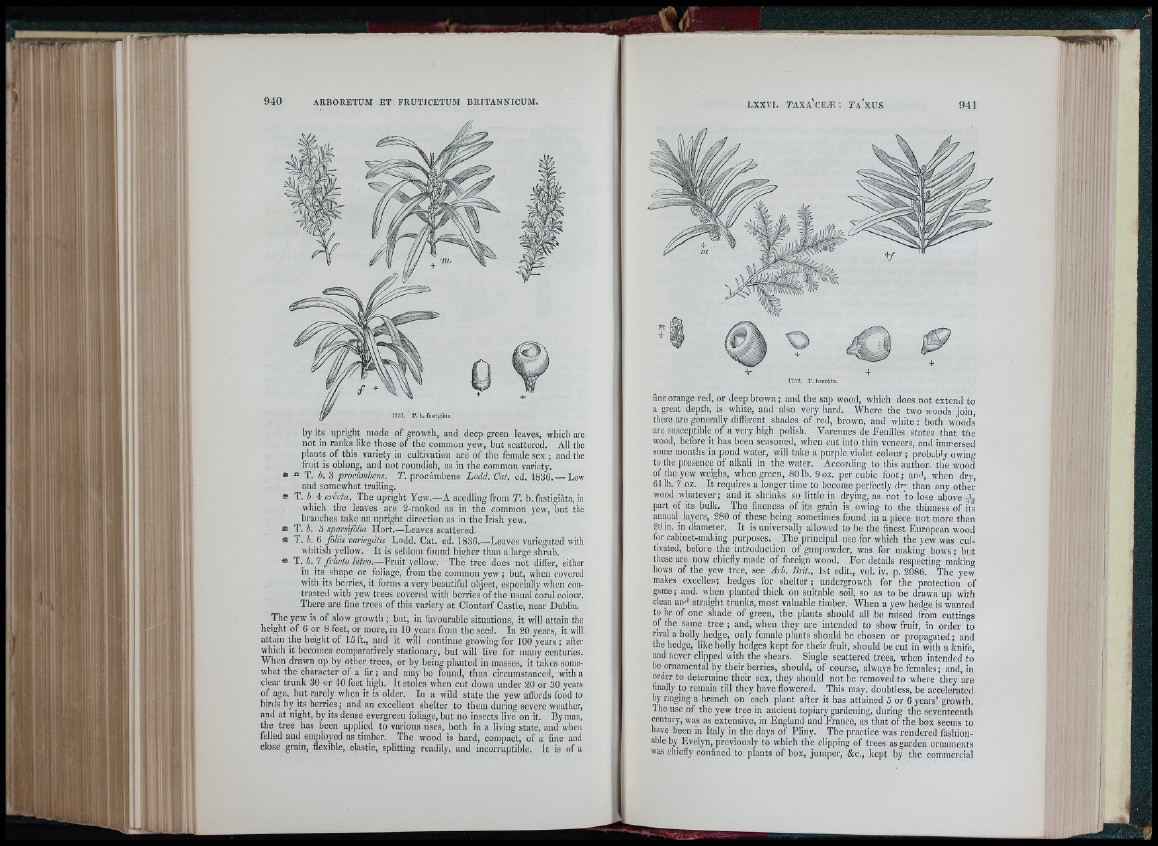
Y
i l l s
r i i ; ?
, - U í
1751. 2'. b. festigiàta
by its upright mode of growth, and deep green leaves, which are
not in ranks like those of the common yew, but scattered. All the
[)lants of this variety in cultivation are of the female sex ; and the
fruit is oblong, and not roundish, as in the common variety.
“■ T. 3 procúmbens. T . procúmbens Lodd. Cat. ed. 1836.— Low
and somewhat trailing
T. b. 4 erécta. The upright Yew.—A seedling from T . b. fastigiàta, in
which the leaves are lAi c. 2 -ranked tiijiYCiA tlO as m in the LliC common L-UllllIJUll
yew, but the
branches take an up
T. è. 5 i
n upright direction as in the Irish yew.
Hort.—Leaves scattered.
Ä T. ¿. 6 folds variegatis^ Lodd. Cat. ed. 1836.—Leaves variegated with
whitish yellow. It is seldom found higher than alarge shrub.
« T. ¿. 7 frúcto lùteo.—Fruit yellow. The tree does not differ, either
in its shape or foliage, from the common yew; but, when covered
with its berries, it forms a very beautiful object, especially when contrasted
with yew trees covered with berries of the usual corul colour.
There aré fine trees of tliis variety at Clontarf Castle, near Dublin.
The yew is of slow growth ; but, in favourable situations, -it will attain the
height of 6 or 8 feet, or more, in 10 years from the seed. In 2 0 years, it will
attain the height of 15 ft., and it will continue growing for 100 years ; after
which it becomes comparatively stationary, but will live for many centuries.
When drawn up by other trees, or by being planted in masses, it takes somewhat
the character of a fir ; and may be found, thus circumstanced, with a
clear trunk 30 or 40 feet high. It stoles when cut down under 2 0 or 30 years
of age, but rarely when it is older. In a wild state the yew affbrds food to
birds by its berries; andan excellent shelter to them during severe weather,
and at night, by its dense evergreen foliage, but no insects live on it. By man,
the tree has been applied to various uses, both in a living state, and when
felled and employed as timber. The wood is hard, compact, of a fine and
close grain, flexible, elastic, splitting readily, and incorruptible. It is of a
9 4 1
1752. T . baccàta.
fine orange reti, or Jeep brown ; and the sap wood, which does not extend to
a great depth, is white, and also veiy hard. Where the two woods join,
there are generally different shades of red, brown, and white : botli woods’
are susceptible of a very high polish. V,arennes de Fenillcs states that tlie
wood, before it has been seasoned, when cut into thin veneers, and imtPer.sed
some months in pond water, will take a purple violet colour ; probabiy owing
to the presence of alkali in the water. According to this author, the wood
of the yew weighs, when green, 80 Ib. 9 oz. per cubic foot ; anO, when dry,
61 lb. 7 oz. It requires a longer time to become perfectly di- than any other
wood whatever; and it .shrinks so little in drying, as n o t'to lose above A
part of its bulk. The fineness of its grain is owing to the thinness of its
annual layers, 280 of these being sometimes found in a piece not more than
2 0 in. in diameter. It is universally allowed to be the finest Furopean wood
for cabinet-making purposes. The principal use for which the yew was cultivated,
befoie the introduction of gunpowder, was for making bows; but
these are now chiefly made of foreign wood. For details respecting making
bows of the yew tree, see Arb. Brit., 1st edit., vol. iv. p. 2086. The yew
makes excellent hedges for shelter ; undergrowth for the protection of
game; and. when planted thick on suitable soil, so as to be drawn up with
clean and straight trunks, most valuable timber. When a yew hedge is wanted
to be of one shade of green, the plants should all be raised from cuttings
of the same tree ; and, when they are intended to show fruit, in order to
rival a holly hedge, only female plants should be chosen or propagated ; and
the hedge, like holly hedges kept for their fruit, should be cut in with a knife,
and never clipped with the shears. Single scattered trees, when intended to’
be ornamental by their berries, should, of course, always be females ; and, in
order to determine their sex, they should not be removed to where they are
finally to remain till they have flowered. This may, doubtless, be accelerated
by ringing a branch on each plant after it has attained 5 or 6 years’ growth.
The use of the yew tree in ancient topiary gardening, during the seventeenth
century, was as extensive, in England and France, as that of the box seems to
have been in Italy in the days of Pliny. The practice was rendered fashionable
by Evelyn, previously to which the clipping of trees as garden ornaments
was chiefly confined to plants of box, juniper, &c., kept by the commercial